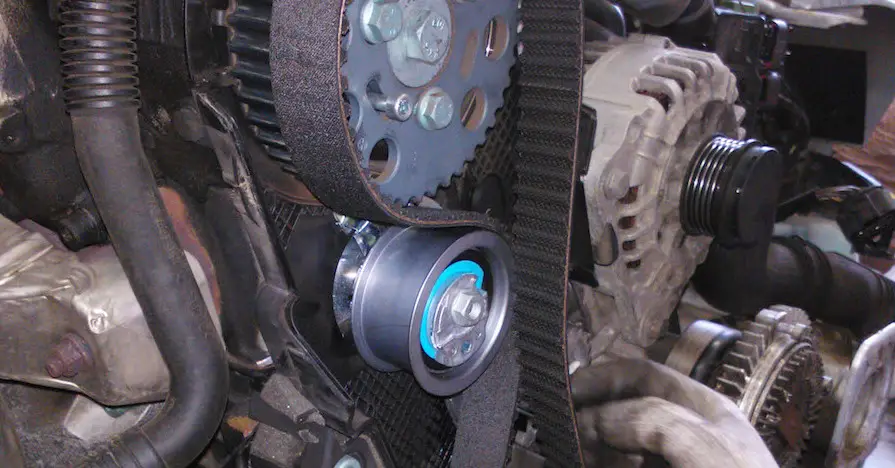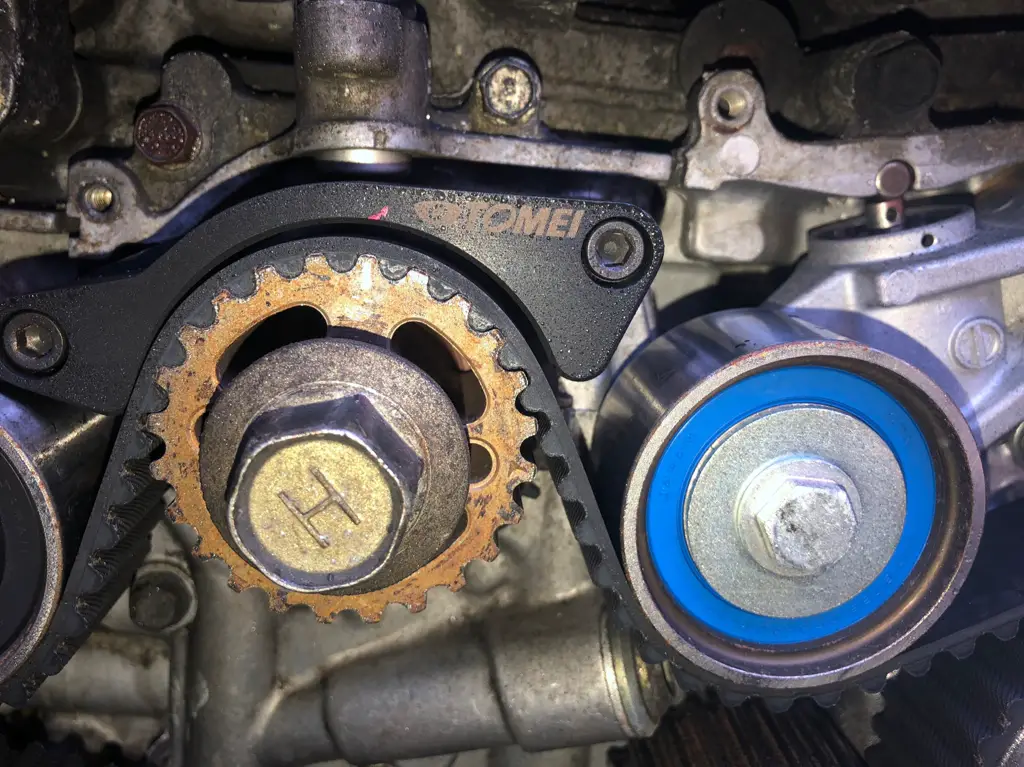A “timing belt jumped” means the belt has slipped, causing engine timing issues. This can lead to misfires or serious engine damage, especially in interference engines. Quick repairs and regular maintenance are essential to prevent major problems.
The timing belt is a crucial component in an internal combustion engine, playing a vital role in synchronizing the engine’s camshaft and crankshaft. This ensures that the engine’s valves open and close at the proper time in relation to the position of the pistons. Without a properly functioning timing belt, the engine won’t run smoothly, and in the worst case, can cause significant damage.
One of the most alarming problems that can occur with a timing belt is when it “jumps” or skips a tooth. This issue can cause serious engine malfunction, and in this post, we’ll explore what happens when a timing belt jumps, the causes, signs, consequences, and how to prevent this problem.

Contents
What Happens When a Timing Belt Jumps?
When we say a timing belt has “jumped,” it refers to the situation where the belt has slipped out of its correct position, typically by skipping a tooth or more on the belt’s teeth. Since the timing belt synchronizes the rotation of the crankshaft and camshaft, any misalignment between them can throw off the timing of the engine’s valves. This misalignment can lead to a range of issues, from poor engine performance to severe engine damage.
A timing belt jump can cause the engine’s pistons to collide with the valves (especially in interference engines), which can bend or break valves and pistons. In extreme cases, this can result in catastrophic engine failure, necessitating expensive repairs or even a complete engine replacement.
Causes of Timing Belt Jumping
Several factors can cause a timing belt to jump. These include:
1. Wear and Tear
Over time, timing belts naturally degrade due to heat, friction, and continuous use. When a timing belt becomes worn, it loses its tension and may begin to slip on the sprockets. If left unaddressed, this can cause the belt to skip teeth and throw off the engine’s timing.
2. Misalignment of Components
If the pulleys, tensioner, or any other related components are not aligned properly, the timing belt can experience uneven wear. Misalignment is usually the result of improper installation, faulty components, or previous repairs done incorrectly.
3. Incorrect Installation
If a mechanic improperly installs the timing belt or tensioner, it can lead to the belt skipping. This is why it’s crucial to have a professional install or replace the timing belt following the manufacturer’s specifications.
4. Faulty Tensioner
The tensioner maintains proper tension on the timing belt. If the tensioner fails or is not working as it should, the belt can slacken, causing it to slip or jump. This is one of the more common causes of timing belt failure.
5. Engine Overheating
Engine overheating can cause the timing belt to lose its elasticity and become brittle. In extreme cases, the belt can break or slip out of place if the engine’s temperature exceeds safe levels.
6. Damaged Pulley or Sprockets
If the pulleys or sprockets that the timing belt runs on become damaged or worn, they may not grip the belt properly. This can result in the belt jumping or skipping teeth.
How to Tell Timing Belt Has Jumped
If the timing belt has jumped, you may notice several signs that something is wrong with your engine. Here are some common symptoms:
1. Engine Misfire
If the timing is off due to a jumped timing belt, the engine may misfire. This happens when the air-fuel mixture is not igniting at the right time, causing rough idling and engine performance issues.
2. Difficulty Starting the Engine
A skipped timing belt can cause the engine to struggle or fail to start because the timing is out of sync.
3. Unusual Engine Noise
If the timing belt jumps and the valves or pistons collide, the engine may produce unusual noises like knocking, popping, or tapping sounds.
4. Poor Engine Performance
Loss of power, rough acceleration, or stalling can all result from a timing belt issue. This occurs when the valves and pistons are not working in sync.
5. Check Engine Light
The check engine light may illuminate if the engine control unit (ECU) detects abnormal engine timing.
Consequences of a Jumped Timing Belt
When a timing belt jumps, the results can range from mild engine performance issues to catastrophic engine damage. Here’s a closer look at the potential consequences:
1. Engine Misfire
If the timing belt skips, the engine’s valves may not open or close at the right time, resulting in a misfire. This can cause rough running and poor fuel efficiency.
2. Valve and Piston Damage (In Interference Engines)
In interference engines, where the pistons and valves share the same space, a jumped timing belt can cause the pistons to collide with the valves. This can bend or break valves, pistons, or even the camshaft, leading to costly repairs.
3. Complete Engine Failure
In the worst-case scenario, a jumped timing belt can cause complete engine failure. This often results from severe internal damage such as a broken timing belt, damaged valves, or cracked engine components.
4. Reduced Engine Life
Even if no immediate damage occurs, a timing belt issue can put stress on other engine components, potentially leading to long-term damage and a reduced engine lifespan.
How to Fix a Timing Belt That Has Jumped
If you suspect that your timing belt has jumped, it’s essential to address the issue immediately. Here’s how the problem is typically fixed:
1. Turn Off the Engine
If you detect issues like engine misfire or strange noises, stop the engine right away to prevent further damage.
2. Inspect the Timing Belt
A mechanic will inspect the timing belt for wear and alignment issues. If the belt is severely damaged, it will need to be replaced.
3. Check the Timing Components
The mechanic will check the camshaft and crankshaft positions, tensioner, pulleys, and other components to ensure proper alignment and function.
4. Repair or Replace Damaged Components
If any parts are found to be damaged (e.g., valves, pistons, or pulleys), they will need to be repaired or replaced. Depending on the severity of the damage, the engine may need to be partially disassembled.
5. Reinstall the Timing Belt
After all necessary repairs, the mechanic will reinstall a new timing belt and ensure it is properly aligned and tensioned according to manufacturer specifications.
6. Test the Engine
After reassembling, the engine will be started to ensure that it runs smoothly and the timing is correct.

Prevention Tips
Preventing a timing belt from jumping is primarily about regular maintenance and proper installation. Here are some tips to help you avoid this issue:
- Replace the Timing Belt on Time : Always replace the timing belt at the manufacturer-recommended interval, typically between 60,000 and 100,000 miles, depending on your vehicle.
- Check for Proper Installation : Ensure that the timing belt, pulleys, and tensioner are correctly installed by a qualified mechanic.
- Inspect the Belt Regularly : Periodically inspect the timing belt for signs of wear, cracks, or damage. Early detection can help prevent a jumped timing belt.
- Use High-Quality Parts : Always use high-quality replacement parts for the timing belt, tensioner, and pulleys to ensure they last as long as possible.
- Keep the Engine Cool : Overheating can damage the timing belt. Make sure your cooling system is functioning correctly to avoid heat-related issues.
Frequently Asked Questions
Here are some FAQs about timing belt jumped –
1. Can a jumped timing belt cause immediate engine failure?
Yes, especially in interference engines, where a jumped timing belt can cause the pistons to collide with the valves, leading to severe engine damage.
2. How can I tell if my timing belt has jumped?
Signs include engine misfires, difficulty starting the engine, unusual engine noises, and poor engine performance.
3. Can I drive with a jumped timing belt?
It’s not recommended. Driving with a jumped timing belt can cause further damage to the engine, potentially leading to complete engine failure.
4. How much does it cost to fix a jumped timing belt?
The cost can vary depending on the severity of the damage, but it typically ranges from $500 to $2,000 or more for parts and labor, especially if valves or pistons are damaged.
5. How often should I replace my timing belt?
Timing belts should generally be replaced every 60,000 to 100,000 miles, depending on your vehicle’s manufacturer recommendations.
Conclusion
A jumped timing belt is a serious issue that can cause significant engine damage. Understanding the causes, recognizing the symptoms, and knowing how to address the problem can help prevent major repairs and costly engine damage. If you suspect your timing belt has jumped, don’t hesitate to consult a professional mechanic immediately to avoid further damage.